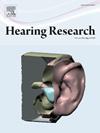锚蛋白对于耳蜗毛细胞的机械传导是必不可少的
IF 2.5
2区 医学
Q1 AUDIOLOGY & SPEECH-LANGUAGE PATHOLOGY
引用次数: 0
摘要
耳蜗毛细胞的机械转导(MET)通道是由TMC1、TMIE和CIB2组成的异质蛋白复合物。这个离子通道的活性被认为是由一个门控弹簧调节的,门控弹簧是一种机械元件,它将声音引起的振动传递给MET通道。在线虫中,TMC-1、TMIE和CIB2的同源基因类似地组装成MET通道,介导轻微的鼻子触摸。对线虫的研究表明,与哺乳动物锚蛋白Ank1、2和3同源的Unc-44线虫编码一个门控弹簧,将线虫的MET通道连接到细胞骨架上。我们发现哺乳动物的锚蛋白在耳蜗毛细胞中表达。使用单和三重条件敲除小鼠,我们证明了Ank1, 2和3对于耳蜗毛细胞的功能是不可或缺的。我们得出的结论是,Ank1、2和3不太可能是哺乳动物耳蜗毛细胞机械转导通道的门控弹簧的组成部分。本文章由计算机程序翻译,如有差异,请以英文原文为准。
Ankyrins are dispensable for mechanotransduction by cochlear hair cells
The mechanotransduction (MET) channels of cochlear hair cells is a heteromeric protein complex consisting of TMC1, TMIE and CIB2. The activity of this ion channel is thought to be regulated by a gating spring, a mechanical element that conveys sound-induced vibrations to the MET channel. In nematodes, orthologs of TMC-1, TMIE and CIB2 similarly assemble into a MET channel mediating light nose-touch. Studies in nematodes have suggested that nematode Unc-44, an ortholog of the mammalian ankyrins Ank1, 2, and 3, encodes a gating spring that tethers the nematode MET channel to the cytoskeleton. Here we show that mammalian ankyrins are expressed in cochlear hair cells. Using single and triple conditional knockout mice, we demonstrate that Ank1, 2, and 3 are dispensable for the function of cochlear hair cells. We concluded that Ank1, 2, and 3 are unlikely to be components of the gating spring that gates mechanotransduction channels in mammalian cochlear hair cells.
求助全文
通过发布文献求助,成功后即可免费获取论文全文。
去求助
来源期刊

Hearing Research
医学-耳鼻喉科学
CiteScore
5.30
自引率
14.30%
发文量
163
审稿时长
75 days
期刊介绍:
The aim of the journal is to provide a forum for papers concerned with basic peripheral and central auditory mechanisms. Emphasis is on experimental and clinical studies, but theoretical and methodological papers will also be considered. The journal publishes original research papers, review and mini- review articles, rapid communications, method/protocol and perspective articles.
Papers submitted should deal with auditory anatomy, physiology, psychophysics, imaging, modeling and behavioural studies in animals and humans, as well as hearing aids and cochlear implants. Papers dealing with the vestibular system are also considered for publication. Papers on comparative aspects of hearing and on effects of drugs and environmental contaminants on hearing function will also be considered. Clinical papers will be accepted when they contribute to the understanding of normal and pathological hearing functions.
 求助内容:
求助内容: 应助结果提醒方式:
应助结果提醒方式:


